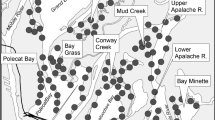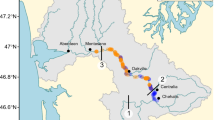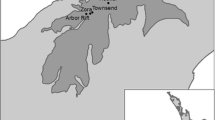Abstract
The Everglades has been greatly reduced and is threatened by land use change and altered hydrology. The Comprehensive Everglades Restoration Plan calls for monitoring and assessment of key ecosystem attributes, one of which is abundance of American alligators. We examined 10 years of alligator night spotlight counts from Arthur R. Marshall Loxahatchee National Wildlife Refuge along two canals and in the interior marsh to determine trends and how dry years affect alligator abundance. Alligators showed population response to hydrologic conditions. In particular, there were declines in abundance after dry years followed by an apparent recovery in abundance in subsequent years. Increases in abundance were lower in the marsh than L-40 Canal. In addition, there was evidence that intensity of dry events affected population dynamics with greater declines observed in years with drier conditions. Results revealed that overall population of alligators increased from 2004 to 2013, but that increases varied by survey route. These results demonstrate that dry years cause a decline in alligator abundance proportional to the intensity of the dry event, and that it is important to make a distinction between canals and marsh when measuring alligator response to hydrology.




Similar content being viewed by others
References
Abtew W, Huebner RS, Ciuca V (2006) Hydrology of the South Florida environment. In: South Florida Water Management District (ed) South Florida environmental report. South Florida Water Management District, West Palm Beach, pp 5.1–5.85
Brandt LA (1989) The status and ecology of the American alligator (Alligator mississippiensis) in Par Pond, Savannah River Site. Thesis, Florida International University
Brandt LA, Portier KM, Kitchens WM (2000) Patterns of change in tree islands in Arthur R. Marshall Loxahatchee National Wildlife Refuge from 1950 to 1991. Wetlands 20:1–14
Bugbee CD (2008) Emergence dynamics of American alligators (Alligator mississippiensis) in Arthur R. Marshall Loxahatchee National Wildlife Refuge: life history and application to statewide alligator surveys. Thesis, University of Florida
Carr A (1967) Alligators, dragons in distress. National Geographic Magazine 131:133–148
Carter CB (2010) Effects of habitat type and structure on detection probabilities of American alligator (Alligator mississippiensis) during night-light counts. Thesis, University of Florida
Chandler RB, King DI (2011) Habitat quality and habitat selection of golden-winged warblers in Costa Rica: an application of hierarchical models for open populations. Journal of Applied Ecology 48:1038–1047
Chimney MJ, Goforth G (2001) Environmental impacts to the Everglades ecosystem: a historical perspective and restoration strategies. Water Science and Technology 44:93–100
Chopp M (2003) A comparison of Everglades alligator production in marsh interior and canal habitats at A.R.M. Loxahatchee National Wildlife Refuge. Thesis, University of Florida
Craighead FC Sr (1968) The role of the alligator in shaping plant communities and maintaining wildlife in the Southern Everglades. Florida Naturalist 41:2–7, 69–74, 94
Dail D, Madsen L (2011) Models for estimating abundance from repeated counts of an open metapopulation. Biometrics 67:577–587
Deitz DC (1979) Behavioral ecology of young American alligators. Dissertation, University of Florida
Delany MF, Abercrombie CL (1986) American alligator food habits in northcentral Florida. Journal of Wildlife Management 50:348–353
Delany MF, Woodward AR, Kiltie RA, Moore CT (2011) Mortality of American alligators attributed to cannibalism. Herpetologica 67:174–185
Fennema RJ, Neidrauer CJ, Johnson RA, MacVicar TK, Perkins WA (1994) A computer model to simulate natural Everglades hydrology. In: Davis SM, Ogden JC (eds) Everglades: the ecosystem and its restoration. St. Lucie, Delray Beach, pp 249–289
Fiske IJ, Chandler RB (2011) Unmarked: an R package for fitting hierarchical models of wildlife occurrence and abundance. Journal of Statistical Software 43:1–23
Fiske IJ, Chandler RB, Royle JA (2010) Unmarked: models for data from unmarked animals. http://cran.r-project.org/web/packages/unmarked/. Accessed 30 Sept 2013
Frederick PC, Ogden JC (2001) Pulsed breeding of long-legged wading birds and the importance of infrequent severe drought conditions in the Florida Everglades. Wetlands 21:484–491
Fujisaki I, Mazzotti FJ, Dorazio RM, Rice KG, Cherkiss M, Jeffery B (2011) Estimating trends in alligator populations from nightlight survey data. Wetlands 31:147–155
Hart KM, Mazzotti FJ, Brandt LA (2012) 2011 Annual assessment update Comprehensive Everglades Restoration Plan (CERP): American alligator density, size, and hole occupancy and American Crocodile juvenile growth & survival. MAP activities 3.1.3.15 and 3.1.3.16 (Greater Everglades Wetlands Module). Prepared for: U.S. Army Corps of Engineers, Jacksonville, FL.
Jacobsen T, Kushlan JA (1984) Population status of the American alligator (Alligator mississippiensis) in Everglades National Park. South Florida Research Center Report, Homestead, p 43
Kushlan JA (1974) Observations of the role of the American alligator (Alligator mississippiensis) in the southern Florida wetlands. Copeia 1974:993–996
Kushlan JA (1990) Wetlands and wildlife, the Everglades perspective in freshwater wetlands and wildlife. In: Sharitz RR, Gibbons JW (eds) CONF-8603101, DOE Symposium Series No 61, Office of Scientific and Technical Information, US Department of Energy, Oak Ridge, pp 773–790
Light SS, Dineen JW (1994) Water control in the Everglades: a historical perspective. In: Davis SM, Ogden JC (eds) Everglades: the ecosystem and its restoration. St. Lucie, Delray Beach, pp 47–84
Loftus WF, Eklund AM (1994) Long-term dynamics of an Everglades fish community. In: Davis SM, Ogden JC (eds) Everglades: the ecosystem and its restoration. St. Lucie, Delray Beach, pp 461–483
Mazzotti FJ, Brandt LA (1994) Ecology of the American alligator in a seasonally fluctuating environment. In: Davis SM, Ogden JC (eds) Everglades: the ecosystem and its restoration. St. Lucie, Delray Beach, pp 485–505
Mazzotti FJ, Best GR, Brandt LA, Cherkiss MS, Jeffery BM, Rice KG (2009) Alligators and crocodiles as indicators for restoration of Everglades ecosystems. Ecological Indicators 9S:137–149
Mazzotti FJ, Hart KM, Jeffery BM, Cherkiss MS, Brandt LA, Fujisaki I, Rice KG (2010) American alligator distribution, size, and hole occupancy and American crocodile juvenile growth and survival. Volume I. MAP RECOVER 2004–2009 Final Summary Report, Fort Lauderdale Research and Education Center, University of Florida, Fort Lauderdale
McIlhenny EA (1935) The alligator’s life history. Christopher Publishing House, Boston
Morea CR (1999) Home range, movement, and habitat use of the American alligator in the Everglades. Thesis, University of Florida
Murphy TM (1977) Distribution, movement, and population dynamics of the American alligator in a thermally altered reservoir. Thesis, University of Georgia
R Core Team (2012) R: a language and environment for statistical computing. R Foundation for Statistical Computing, Vienna, Austria. ISBN 3-900051-07-0, http://www.R-project.org/. Accessed 30 Sept 2013
RECOVER (2001) Monitoring and assessment plan, Comprehensive Everglades Restoration Plan C/O US Army Corps of Engineers, Jacksonville District, Jacksonville and South Florida Water Management District, West Palm Beach
Rhodes WE, Wilkinson PM (1994) Alligator night–light surveys of impoundment habitats in coastal South Carolina—a preliminary validation. In: Proceedings of the 12th Working Meeting, Crocodile Specialist Group, Vol 2. IUCN, Gland Switzerland. pp 66–73
Rice KG, Mazzotti FJ, Brandt LA, Tarboton KC (2004) Alligator habitat suitability index. In: Tarboton KC, Irizzarry-Ortiz MM, Loucks DP, Davis SM, Obeysekera JT (eds) Habitat suitability indices for evaluating water management alternatives. South Florida Water Management District Office of Modeling Technical Report, West Palm Beach, pp 93–110
Richardson JR, Bryant WL, Kitchens WM, Mattson JE, Pope KR (1990) An evaluation of refuge habitats and relationships to water quality, quantity, and hydroperiod. Florida Cooperative Fish and Wildlife Research Unit, Gainesville
Royle JA (2004) N-mixture models for estimating population size from spatially replicated counts. Biometrics 60:108–115
Ruetz CR III, Trexler JC, Jordan F, Loftus WF, Perry SA (2005) Population dynamics of wetland fishes: spatio-temporal patterns synchronized by hydrological disturbance? Journal of Animal Ecology 74:322–332
Taylor D, Neal W (1984) Management implications of size-class frequency distributions in Louisiana alligator populations. Wildlife Society Bulletin 12:312–319
Trexler JC, Loftus WF, Perry S (2005) Disturbance frequency and community structure in a twenty-five year intervention study. Oecologia 145:140–152
US Army Corps of Engineers (1994) Preliminary Finding of No Significant Impact (FONSI) and Environmental Assessment Water Conservation Area No. 1 Regulation Schedule Modification. US Army Corps of Engineers, Jacksonville
Wood JM, Woodward AR, Humphrey S, Hines TC (1985) Night counts as an index of American alligator population trends. Wildlife Society Bulletin 13:262–302
Woodward AR, Moore CT (1990) Statewide alligator surveys. Florida Game and Freshwater Fish Commission Final Report, Tallahassee
Woodward AR, Rice KG, Linda SB (1996) Estimating sighting proportions of American alligators during night-light and aerial helicopter surveys. Proceedings of the Annual Conference of the Southeastern Association of Fish and Wildlife Agencies 50:509–519
Acknowledgments
We thank all of the volunteers who helped with the alligator surveys, D. Bucklin for data preparation, R. Chandler for assistance with the data analysis, B. Glorioso for assistance with figures, and the U.S. Geological Survey for maintaining the water level gauges. This study was funded by the U.S. Army Corps of Engineers Comprehensive Everglades Restoration Plan Restoration Coordination and Verification Monitoring and Assessment Program and the U.S. Geological Survey Greater Everglades Priority Ecosystems Sciences program. Views expressed here do not necessarily represent the views of the U.S. Fish and Wildlife Service. Any use of trade, firm, or product names is for descriptive purposes only and does not imply endorsement by the U.S. Government.
Author information
Authors and Affiliations
Corresponding author
Rights and permissions
About this article
Cite this article
Waddle, J.H., Brandt, L.A., Jeffery, B.M. et al. Dry Years Decrease Abundance of American Alligators in the Florida Everglades. Wetlands 35, 865–875 (2015). https://doi.org/10.1007/s13157-015-0677-8
Received:
Accepted:
Published:
Issue Date:
DOI: https://doi.org/10.1007/s13157-015-0677-8




